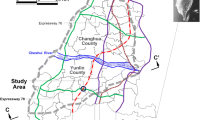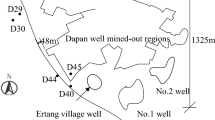Abstract
Taiwan High Speed Rail (THSR), which began operations in January 2007, passes through an area in Yunlin County where the largest cumulative subsidence measured during 1992–2006 exceeds 100 cm. Leveling benchmarks, GPS pillars and multi-level monitoring wells were deployed in this area to collect detailed subsidence data from October 2003 to 2006. Leveling is carried out on both ground benchmarks and survey bolts attached to THSR columns. Minimum constraint solutions of leveling networks produce estimated heights accurate to a few mm. Special attention is paid to code smoothing, ionospheric, tropospheric and ocean tidal loading (OTL) effects, so that height estimates from GPS are optimal. Leveling and GPS-derived height changes are consistent to 1 cm, and show that from Stations 210 to 240K of TSHR, the subsidence is bowl shaped. Measurements of sediment compaction in specific depth intervals at three monitoring wells indicate that most of the subsidence is caused by sediment compaction at depths from 50 to 300 m. The major compaction occurs in the interval 220–300 m and is attributed to ground water withdrawal. Large angular deflections as determined from subsidence measurements are detected at some columns, but are below the upper bound (1/1,000) of tolerance specified in the safety code. With the current subsidence and sediment compaction, no significantly reduced loading capacity of the columns is expected to occur. For a safe THSR operation, subsidence and sediment-compaction monitoring should be continued, and current ground water withdrawal in Yunlin must be reduced or stopped.










Similar content being viewed by others
References
Abidin ZH, Djaja R, Darmawan D, Hadi S, Akbar A, Rajiyowiryono H, Sudibyo Y, Meilan I, Kasuma MA, Kahar J, Subarya C (2001) Land subsidence of Jakarta (Indonesia) and its geodetic monitoring system. Nat Hazards 23:365–387
Beutler G, Brockmann E, Dach T, Fridez P, Gurtner W, Hugentobler U, Johnson J, Mervart L, Rothacher M, Schaer S, Springer T, Weber R (2001) Bernese GPS software version 4.2. Astronomical Institute, University of Bern, Bern, 515 pp
Caspary WF (1987) Concepts of network and deformation analysis. Monograph 11, School of Surveying, University of New South Wales, Kensington, NSW, Australia, 183 pp
Dodson AH, Shardlow PJ, Hubbard LCM, Elgered G, Jarlemark POJ (1996) Wet tropospheric effects on precise relative GPS height determination. J Geodesy 70:188–202
Hwang C, Hsiao YS (2003) Orthometric corrections from leveling, gravity, density and elevation data: a case study in Taiwan. J Geodesy 77:279–291
Koch KR (1987) Parameter estimation and hypothesis testing in linear models. Springer, Berlin, 378 pp
Laier JE, Brenner WH (1984) Instrumentation performance in soft clay soils (a case history). In: Yong RN, Townsend FC (eds) Sedimentation consolidation models—prediction and validation. American Society of Civil Engineers, Reston, VA, pp 426–445
Leick A (2004) GPS satellite surveying, 3rd edn. Wiley, New Jersey, 435 pp
Lin ML, Chan JB (1997) A model analysis of ground subsidence of the Taisei-Mailiao area. In: Proceedings of the 7th conference on current research in geotechnical engineering in Taiwan, pp 891–898 (in Chinese)
Liu CS, Hung WC (2006) Taiwan land subsidence monitoring and surveying analysis. Report of Industrial Technology Research Institute (ITRI), Hsinchu (in Chinese)
Liu CH, Pan YW, Liao JJ, Hung WC (2004) Estimating coefficients of volume compressibility from compaction of strata and piezometric changes in a multiaquifer system in west Taiwan. Eng Geol 75:33–47
Motagh M, Djamour Y, Walter TR, Wetzel HU, Zschau J, Arabi S (2007) Land subsidence in Mashhad Valley, northeast Iran: results from InSAR, leveling and GPS. Geophys J Int 168:518–526
Teatini P, Tosi L, Strozzi T, Carbognin L, Wegmuller U, Rizzetto F (2005) Mapping regional land displacements in the Venice coastland by an integrated monitoring system. Remote Sens Environ 98:403–413
Terzaghi K, Peck RB, Mesri G (1996) Soil mechanics in engineering practice, 3rd edn. Wiley-Interscience, New York, 592 pp
Wolf PR, Ghilani C (2005) Elementary surveying, an introduction to geomatics, 11th edn. Prentice Hall, 944 pp
Zilkoski DB, D’Onofrio JD, Frakes SJ (1997) Guidelines for establishing GPS-derived ellipsoid heights (Standards: 2 cm and 5 cm) version 4.3, NOAA technical memorandum NOS NGS-58, Silver Spring, MD. http://www.ngs.noaa.gov/PUBS_LIB/NGS-58.html
Acknowledgment
This study is supported by National Science Council (project number: 95-2221-E-009-353), and Water Resource Agency, Department of Economics, Taiwan.
Author information
Authors and Affiliations
Corresponding author
Rights and permissions
About this article
Cite this article
Hwang, C., Hung, WC. & Liu, CH. Results of geodetic and geotechnical monitoring of subsidence for Taiwan High Speed Rail operation. Nat Hazards 47, 1–16 (2008). https://doi.org/10.1007/s11069-007-9211-5
Received:
Accepted:
Published:
Issue Date:
DOI: https://doi.org/10.1007/s11069-007-9211-5




